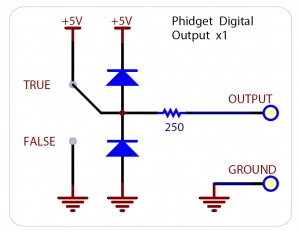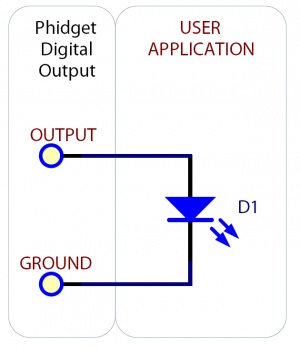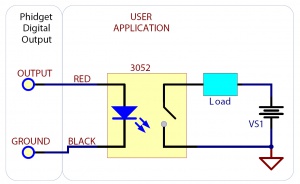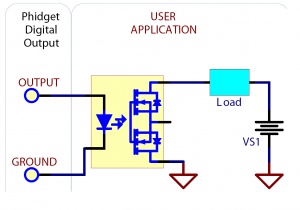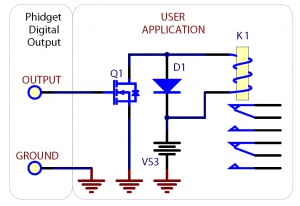|
Notice: This page contains information for the legacy Phidget21 Library. Phidget21 is out of support. Bugfixes may be considered on a case by case basis. Phidget21 does not support VINT Phidgets, or new USB Phidgets released after 2020. We maintain a selection of legacy devices for sale that are supported in Phidget21. We recommend that new projects be developed against the Phidget22 Library.
|
Digital Output Primer
Digital Outputs can be used to drive LEDs, solid state relays, and transistors (or anything that will accept a CMOS signal). Digital outputs can be used to control devices that accept a +5V control signal. With transistors and some electronics experience, other devices can be controlled, such as buzzers, lights, larger LEDs, relays.
Specifications and Features
The 250 ohm resistance is internal to the PhidgetInterfaceKit 8/8/8, and limits the current that can flow through the output. This is intended to protect the device from being damaged if there is a short to ground or if an LED is used. The output is intended to drive TTL or CMOS inputs; it is not designed to provide power to an external circuit.
Ground Protection
Ground terminals on the InterfaceKit share a common ground with USB ground. Because they are not internally isolated, these terminals will expose the USB ground potential of the PC to which they are connected. Be sure you are completely familiar with any circuit you intend to connect to the InterfaceKit before it is connected. If a reverse voltage or dangerously high voltage is applied to the input or output terminals, damage to the Phidget or the PC may result.
5 Volt Terminal Block
For users who need it, we provide 5V on the terminal block next to Digital Output 7.
Using the Digital Outputs
Here are some circuit diagrams that illustrate how to connect various devices to the digital outputs on your Phidget.
Driving an LED with the Digital Output
Connecting an LED to a digital output is simple. Wire the anode to a digital output labeled 0 to 7 on the Interface Kit, and the cathode to a supplied ground, labeled G.
Using a 3052 SSR Board with a Digital Output
Setting the digital output to true causes the output of the 3052 to turn on. This can be used to control AC or DC devices.
The load can also be switched with the 3052 on the high side. High side switching is helpful for powering more complicated circuitry that cannot tolerate having multiple grounds.
Isolating a Digital Output with a MOSFET based SSR
It’s possible to wire up your own Solid State Relay to the digital output. MOSFET based SSRs have the advantage that they can be understood as being a simple switch.
There are many other types of SSRs that are more suitable for controlling higher power, higher voltage AC devices that can also be controlled in the same fashion.
Isolating a Digital Output with an Optocoupler
In some applications, particularly where there is a lot of electrical noise (automotive), or where you want maximum protection of the circuitry (interactive installations, kiosks), electrical isolation buys you a huge margin of protection. Driving the LED causes the output transistor to sink current.
The maximum current through the transistor will depend in part on the characteristics of the optocoupler.
Controlling a Relay with a N-Channel MOSFET
A inexpensive mosfet and flyback diode can be used to control larger loads - relays for example - directly from the digital output. Be sure to use a Logic-Level MOSFET so that the +5V Digital Output is able to turn it on.
Controlling a Relay with a NPN Transistor
This circuit is very similar to the N-channel mosfet - but you may already have NPN transistors on hand.
Using a 3051 Dual Relay Board with one or two Digital Outputs
The 3051 Dual Relay Board is designed to be used with the PhidgetInterfaceKit 8/8/8.
An Analog Input can be used to supply power to the relays, and one or two digital outputs used to control the relays.
The 3051 is a good option if you need a couple relays in your project.
Known Issues
Known Issues:
We need to tell users to pay attention to the update rate of their interface kit. If their program changes the state of a digital output twice without some kind of delay or other time-consuming instruction in between, the interface kit may not register the change.

